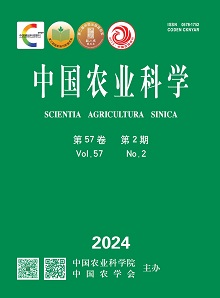【Objective】 Rational close planting and fertilization can effectively coordinate the competition among individuals, improve the light environment of the population and build a high-yield population, which is an important way to increase crop yield. The effects of different planting densities and fertilization levels on lodging resistance and yield of common buckwheat were discussed to provide technical reference for high yield and high yield cultivation of buckwheat. 【Method】 In this study, Xinong D4103, a new isostyle common buckwheat variety, was used as the experimental material, and Xinong 9976, the main cultivated variety in the Loess Plateau, was used as the control, and the two-factor split plot design was adopted. The main factors were two planting densities, namely D1: 9.0×105 plants/hm2 and D2: 1.35×106 plants/hm2. The secondary factors were low, medium and high fertilization levels, which were N: 120, P2O5: 76.8, K2O: 56.4 kg·hm-2 (F1), N: 180, P2O5: 115.2, K2O: 84.6 kg·hm-2 (F2), N: 240, P2O5: 153.6, K2O: 112.8 kg·hm-2 (F3) respectively, which were carried out in Yulin Experimental Station of Northwest A&F University in 2021-2022. The effects of canopy structure, photosynthetic characteristics, yield, yield components and lodging characteristics of common buckwheat population under different planting densities and fertilization levels were studied.【Result】 The two-year field experiment showed that with the increase of planting density, the leaf area index (LAI) of common buckwheat population increased significantly, the photosynthetic effective radiation (PAR) and relative chlorophyll content (SPAD) decreased significantly, and the photosynthetic capacity of leaves was weakened. Fertilization significantly increased LAI, SPAD and photosynthetic capacity of common buckwheat population, and decreased PAR. Compared with lower fertilizer level, the LAI, SPAD, net photosynthetic rate (Pn), stomatal conductance (Gs) and transpiration rate (Tr) of medium fertilizer level increased by 14.6%, 6.7%, 15.3%, 15.2% and 16.6% on average, while PAR and intercellular CO2 concentration (Ci) decreased by 4.5% and 6.7% on average. Compared with D1, the plant height, height of gravity center, length of the second internode, lodging rate and lodging index of D2 increased by 9.6%, 12.5%, 24.7%, 19.8% and 26.2% on average, while the diameter, fullness, flexural strength of the second internode and fresh weight of whole plant decreased by 13.1%, 7.4%, 18.3% and 8.5%. Increased fertilizer application at the same density, the plant height, center of gravity height, length of the second internode, fresh weight of the whole plant, lodging rate and lodging index increased gradually, while the diameter, fullness, flexural strength of the second internode increased first and then decreased. The yield of common buckwheat was significantly increased by increasing the planting density and fertilization level. The yield of Xinong D4103 reached the maximum in D2F2 treatment, which was 15.1% higher than that of D1F1 and 17.0% higher than that of the control variety under the same fertilization amount. 【Conclusion】 Constructing a reasonable population structure is helpful to increase the light receiving area, improve photosynthetic characteristics, reduce the lodging rate in the field and increase yield. Therefore, Xinong D4103, an isostyle common buckwheat variety in the Loess Plateau, recommended the planting density of 1.35×106 plants/hm2, and the fertilizer application rate of medium fertilization level (N: 180, P2O5: 115.2, K2O: 84.6 kg·hm-2)









